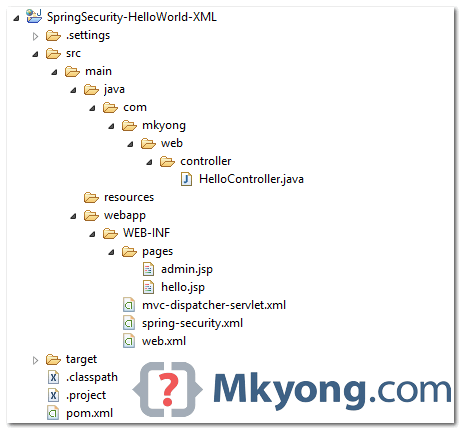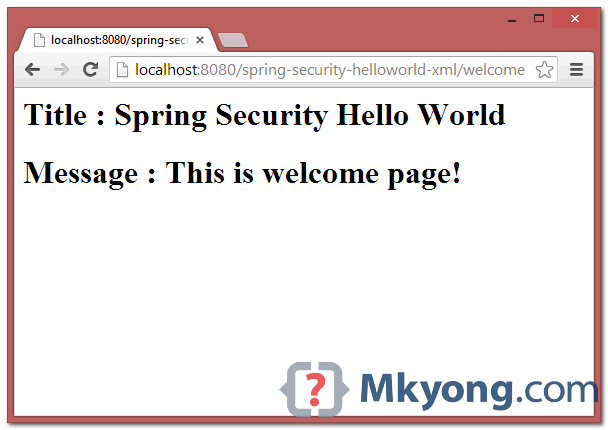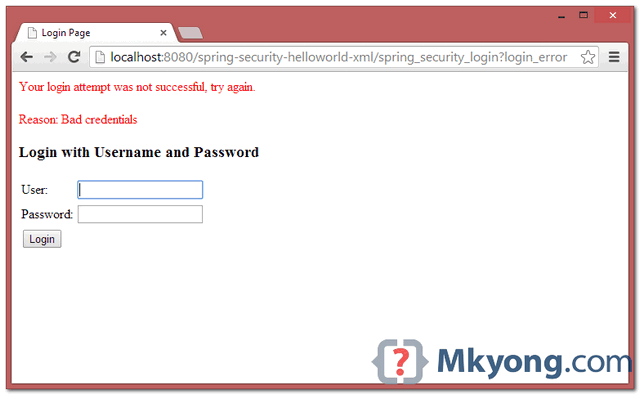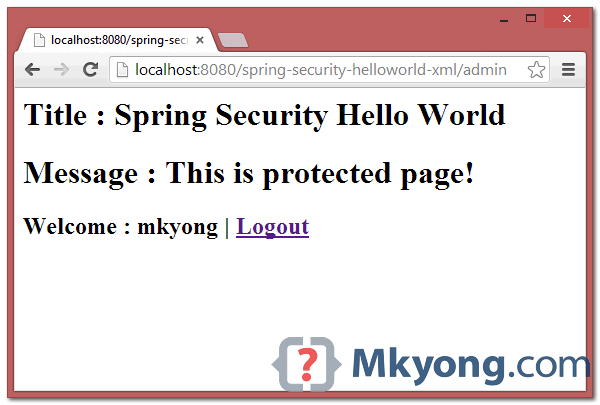Spring Security hello world example
来源:互联网 发布:讨鬼传极优化 编辑:程序博客网 时间:2024/05/22 08:15
Spring Security hello world example
By mkyong | August 16, 2011 | Last Updated : April 2, 2014
In this tutorial, we will show you how to integrate Spring Security with a Spring MVC web application to secure a URL access. After implementing Spring Security, to access the content of an “admin” page, users need to key in the correct “username” and “password”.
Technologies used :
Spring 3.2.8.RELEASE
Spring Security 3.2.3.RELEASE
Eclipse 4.2
JDK 1.6
Maven 3
Note
Spring Security 3.0 requires Java 5.0 Runtime Environment or higher
1. Project Demo
https://youtu.be/hblHPyMuHJc
2. Directory Structure
Review the final directory structure of this tutorial.

spring-security-helloworld-directory
3. Spring Security Dependencies
To use Spring security, you need spring-security-web and spring-security-config.
pom.xml
<properties>
<jdk.version>1.6</jdk.version>
<spring.version>3.2.8.RELEASE</spring.version>
<spring.security.version>3.2.3.RELEASE</spring.security.version>
<jstl.version>1.2</jstl.version>
</properties>
<dependencies>
<!-- Spring dependencies -->
<dependency>
<groupId>org.springframework</groupId>
<artifactId>spring-core</artifactId>
<version>${spring.version}</version>
</dependency>
<dependency>
<groupId>org.springframework</groupId>
<artifactId>spring-web</artifactId>
<version>${spring.version}</version>
</dependency>
<dependency>
<groupId>org.springframework</groupId>
<artifactId>spring-webmvc</artifactId>
<version>${spring.version}</version>
</dependency>
<!-- Spring Security -->
<dependency>
<groupId>org.springframework.security</groupId>
<artifactId>spring-security-web</artifactId>
<version>${spring.security.version}</version>
</dependency>
<dependency>
<groupId>org.springframework.security</groupId>
<artifactId>spring-security-config</artifactId>
<version>${spring.security.version}</version>
</dependency>
<!-- jstl for jsp page -->
<dependency>
<groupId>jstl</groupId>
<artifactId>jstl</artifactId>
<version>${jstl.version}</version>
</dependency>
</dependencies>
4. Spring MVC Web Application
A simple controller :
If URL = /welcome or / , return hello page.
If URL = /admin , return admin page.
Later, we will show you how to use Spring Security to secure the “/admin” URL with a user login form.
HelloController.java
package com.mkyong.web.controller;
import org.springframework.stereotype.Controller;
import org.springframework.web.bind.annotation.RequestMapping;
import org.springframework.web.bind.annotation.RequestMethod;
import org.springframework.web.servlet.ModelAndView;
@Controller
public class HelloController {
@RequestMapping(value = { "/", "/welcome**" }, method = RequestMethod.GET)
public ModelAndView welcomePage() {
ModelAndView model = new ModelAndView();
model.addObject("title", "Spring Security Hello World");
model.addObject("message", "This is welcome page!");
model.setViewName("hello");
return model;
}
@RequestMapping(value = "/admin**", method = RequestMethod.GET)
public ModelAndView adminPage() {
ModelAndView model = new ModelAndView();
model.addObject("title", "Spring Security Hello World");
model.addObject("message", "This is protected page!");
model.setViewName("admin");
return model;
}
}
Two JSP pages.
hello.jsp
<%@page session="false"%>
<html>
<body>
<h1>Title : ${title}</h1>
<h1>Message : ${message}</h1>
</body>
</html>
admin.jsp
<%@taglib prefix="c" uri="http://java.sun.com/jsp/jstl/core"%>
<%@page session="true"%>
<html>
<body>
<h1>Title : ${title}</h1>
<h1>Message : ${message}</h1>
<c:if test="${pageContext.request.userPrincipal.name != null}">
<h2>Welcome : ${pageContext.request.userPrincipal.name}
| <a href="<c:url value="/j_spring_security_logout" />" > Logout</a></h2>
</c:if>
</body>
</html>
mvc-dispatcher-servlet.xml
<beans xmlns="http://www.springframework.org/schema/beans"
xmlns:context="http://www.springframework.org/schema/context"
xmlns:xsi="http://www.w3.org/2001/XMLSchema-instance"
xsi:schemaLocation="
http://www.springframework.org/schema/beans
http://www.springframework.org/schema/beans/spring-beans-3.0.xsd
http://www.springframework.org/schema/context
http://www.springframework.org/schema/context/spring-context-3.0.xsd">
<context:component-scan base-package="com.mkyong.*" />
<bean
class="org.springframework.web.servlet.view.InternalResourceViewResolver">
<property name="prefix">
<value>/WEB-INF/pages/</value>
</property>
<property name="suffix">
<value>.jsp</value>
</property>
</bean>
</beans>
5. Spring Security : User Authentication
Create a Spring Security XML file.
spring-security.xml
<beans:beans xmlns="http://www.springframework.org/schema/security"
xmlns:beans="http://www.springframework.org/schema/beans"
xmlns:xsi="http://www.w3.org/2001/XMLSchema-instance"
xsi:schemaLocation="http://www.springframework.org/schema/beans
http://www.springframework.org/schema/beans/spring-beans-3.0.xsd
http://www.springframework.org/schema/security
http://www.springframework.org/schema/security/spring-security-3.2.xsd">
<http auto-config="true">
<intercept-url pattern="/admin**" access="ROLE_USER" />
</http>
<authentication-manager>
<authentication-provider>
<user-service>
<user name="mkyong" password="123456" authorities="ROLE_USER" />
</user-service>
</authentication-provider>
</authentication-manager>
</beans:beans>
It tells, only user “mkyong” is allowed to access the /admin URL.
6. Integrate Spring Security
To integrate Spring security with a Spring MVC web application, just declares DelegatingFilterProxy as a servlet filter to intercept any incoming request.
web.xml
<web-app id="WebApp_ID" version="2.4"
xmlns="http://java.sun.com/xml/ns/j2ee"
xmlns:xsi="http://www.w3.org/2001/XMLSchema-instance"
xsi:schemaLocation="http://java.sun.com/xml/ns/j2ee
http://java.sun.com/xml/ns/j2ee/web-app_2_4.xsd">
<display-name>Spring MVC Application</display-name>
<!-- Spring MVC -->
<servlet>
<servlet-name>mvc-dispatcher</servlet-name>
<servlet-class>org.springframework.web.servlet.DispatcherServlet
</servlet-class>
<load-on-startup>1</load-on-startup>
</servlet>
<servlet-mapping>
<servlet-name>mvc-dispatcher</servlet-name>
<url-pattern>/</url-pattern>
</servlet-mapping>
<listener>
<listener-class>org.springframework.web.context.ContextLoaderListener
</listener-class>
</listener>
<!-- Loads Spring Security config file -->
<context-param>
<param-name>contextConfigLocation</param-name>
<param-value>
/WEB-INF/spring-security.xml
</param-value>
</context-param>
<!-- Spring Security -->
<filter>
<filter-name>springSecurityFilterChain</filter-name>
<filter-class>org.springframework.web.filter.DelegatingFilterProxy
</filter-class>
</filter>
<filter-mapping>
<filter-name>springSecurityFilterChain</filter-name>
<url-pattern>/*</url-pattern>
</filter-mapping>
</web-app>
7. Demo
That’s all, but wait… where’s the login form? No worry, if you do not define any custom login form, Spring will create a simple login form automatically.
Custom Login Form
Read this “Spring Security form login example” to understand how to create a custom login form in Spring Security.
1. Welcome Page – http://localhost:8080/spring-security-helloworld-xml/welcome

spring-security-helloworld-welcome
2. Try to access /admin page, Spring Security will intercept the request and redirect to /spring_security_login, and a predefined login form is displayed.

spring-security-helloworld-login
3. If username and password is incorrect, error messages will be displayed, and Spring will redirect to this URL /spring_security_login?login_error.

spring-security-helloworld-login-error
4. If username and password are correct, Spring will redirect the request to the original requested URL and display the page.

spring-security-helloworld-admin
By mkyong | August 16, 2011 | Last Updated : April 2, 2014
In this tutorial, we will show you how to integrate Spring Security with a Spring MVC web application to secure a URL access. After implementing Spring Security, to access the content of an “admin” page, users need to key in the correct “username” and “password”.
Technologies used :
Spring 3.2.8.RELEASE
Spring Security 3.2.3.RELEASE
Eclipse 4.2
JDK 1.6
Maven 3
Note
Spring Security 3.0 requires Java 5.0 Runtime Environment or higher
1. Project Demo
https://youtu.be/hblHPyMuHJc
2. Directory Structure
Review the final directory structure of this tutorial.

spring-security-helloworld-directory
3. Spring Security Dependencies
To use Spring security, you need spring-security-web and spring-security-config.
pom.xml
<properties>
<jdk.version>1.6</jdk.version>
<spring.version>3.2.8.RELEASE</spring.version>
<spring.security.version>3.2.3.RELEASE</spring.security.version>
<jstl.version>1.2</jstl.version>
</properties>
<dependencies>
<!-- Spring dependencies -->
<dependency>
<groupId>org.springframework</groupId>
<artifactId>spring-core</artifactId>
<version>${spring.version}</version>
</dependency>
<dependency>
<groupId>org.springframework</groupId>
<artifactId>spring-web</artifactId>
<version>${spring.version}</version>
</dependency>
<dependency>
<groupId>org.springframework</groupId>
<artifactId>spring-webmvc</artifactId>
<version>${spring.version}</version>
</dependency>
<!-- Spring Security -->
<dependency>
<groupId>org.springframework.security</groupId>
<artifactId>spring-security-web</artifactId>
<version>${spring.security.version}</version>
</dependency>
<dependency>
<groupId>org.springframework.security</groupId>
<artifactId>spring-security-config</artifactId>
<version>${spring.security.version}</version>
</dependency>
<!-- jstl for jsp page -->
<dependency>
<groupId>jstl</groupId>
<artifactId>jstl</artifactId>
<version>${jstl.version}</version>
</dependency>
</dependencies>
4. Spring MVC Web Application
A simple controller :
If URL = /welcome or / , return hello page.
If URL = /admin , return admin page.
Later, we will show you how to use Spring Security to secure the “/admin” URL with a user login form.
HelloController.java
package com.mkyong.web.controller;
import org.springframework.stereotype.Controller;
import org.springframework.web.bind.annotation.RequestMapping;
import org.springframework.web.bind.annotation.RequestMethod;
import org.springframework.web.servlet.ModelAndView;
@Controller
public class HelloController {
@RequestMapping(value = { "/", "/welcome**" }, method = RequestMethod.GET)
public ModelAndView welcomePage() {
ModelAndView model = new ModelAndView();
model.addObject("title", "Spring Security Hello World");
model.addObject("message", "This is welcome page!");
model.setViewName("hello");
return model;
}
@RequestMapping(value = "/admin**", method = RequestMethod.GET)
public ModelAndView adminPage() {
ModelAndView model = new ModelAndView();
model.addObject("title", "Spring Security Hello World");
model.addObject("message", "This is protected page!");
model.setViewName("admin");
return model;
}
}
Two JSP pages.
hello.jsp
<%@page session="false"%>
<html>
<body>
<h1>Title : ${title}</h1>
<h1>Message : ${message}</h1>
</body>
</html>
admin.jsp
<%@taglib prefix="c" uri="http://java.sun.com/jsp/jstl/core"%>
<%@page session="true"%>
<html>
<body>
<h1>Title : ${title}</h1>
<h1>Message : ${message}</h1>
<c:if test="${pageContext.request.userPrincipal.name != null}">
<h2>Welcome : ${pageContext.request.userPrincipal.name}
| <a href="<c:url value="/j_spring_security_logout" />" > Logout</a></h2>
</c:if>
</body>
</html>
mvc-dispatcher-servlet.xml
<beans xmlns="http://www.springframework.org/schema/beans"
xmlns:context="http://www.springframework.org/schema/context"
xmlns:xsi="http://www.w3.org/2001/XMLSchema-instance"
xsi:schemaLocation="
http://www.springframework.org/schema/beans
http://www.springframework.org/schema/beans/spring-beans-3.0.xsd
http://www.springframework.org/schema/context
http://www.springframework.org/schema/context/spring-context-3.0.xsd">
<context:component-scan base-package="com.mkyong.*" />
<bean
class="org.springframework.web.servlet.view.InternalResourceViewResolver">
<property name="prefix">
<value>/WEB-INF/pages/</value>
</property>
<property name="suffix">
<value>.jsp</value>
</property>
</bean>
</beans>
5. Spring Security : User Authentication
Create a Spring Security XML file.
spring-security.xml
<beans:beans xmlns="http://www.springframework.org/schema/security"
xmlns:beans="http://www.springframework.org/schema/beans"
xmlns:xsi="http://www.w3.org/2001/XMLSchema-instance"
xsi:schemaLocation="http://www.springframework.org/schema/beans
http://www.springframework.org/schema/beans/spring-beans-3.0.xsd
http://www.springframework.org/schema/security
http://www.springframework.org/schema/security/spring-security-3.2.xsd">
<http auto-config="true">
<intercept-url pattern="/admin**" access="ROLE_USER" />
</http>
<authentication-manager>
<authentication-provider>
<user-service>
<user name="mkyong" password="123456" authorities="ROLE_USER" />
</user-service>
</authentication-provider>
</authentication-manager>
</beans:beans>
It tells, only user “mkyong” is allowed to access the /admin URL.
6. Integrate Spring Security
To integrate Spring security with a Spring MVC web application, just declares DelegatingFilterProxy as a servlet filter to intercept any incoming request.
web.xml
<web-app id="WebApp_ID" version="2.4"
xmlns="http://java.sun.com/xml/ns/j2ee"
xmlns:xsi="http://www.w3.org/2001/XMLSchema-instance"
xsi:schemaLocation="http://java.sun.com/xml/ns/j2ee
http://java.sun.com/xml/ns/j2ee/web-app_2_4.xsd">
<display-name>Spring MVC Application</display-name>
<!-- Spring MVC -->
<servlet>
<servlet-name>mvc-dispatcher</servlet-name>
<servlet-class>org.springframework.web.servlet.DispatcherServlet
</servlet-class>
<load-on-startup>1</load-on-startup>
</servlet>
<servlet-mapping>
<servlet-name>mvc-dispatcher</servlet-name>
<url-pattern>/</url-pattern>
</servlet-mapping>
<listener>
<listener-class>org.springframework.web.context.ContextLoaderListener
</listener-class>
</listener>
<!-- Loads Spring Security config file -->
<context-param>
<param-name>contextConfigLocation</param-name>
<param-value>
/WEB-INF/spring-security.xml
</param-value>
</context-param>
<!-- Spring Security -->
<filter>
<filter-name>springSecurityFilterChain</filter-name>
<filter-class>org.springframework.web.filter.DelegatingFilterProxy
</filter-class>
</filter>
<filter-mapping>
<filter-name>springSecurityFilterChain</filter-name>
<url-pattern>/*</url-pattern>
</filter-mapping>
</web-app>
7. Demo
That’s all, but wait… where’s the login form? No worry, if you do not define any custom login form, Spring will create a simple login form automatically.
Custom Login Form
Read this “Spring Security form login example” to understand how to create a custom login form in Spring Security.
1. Welcome Page – http://localhost:8080/spring-security-helloworld-xml/welcome

spring-security-helloworld-welcome
2. Try to access /admin page, Spring Security will intercept the request and redirect to /spring_security_login, and a predefined login form is displayed.

spring-security-helloworld-login
3. If username and password is incorrect, error messages will be displayed, and Spring will redirect to this URL /spring_security_login?login_error.

spring-security-helloworld-login-error
4. If username and password are correct, Spring will redirect the request to the original requested URL and display the page.

spring-security-helloworld-admin
0 0
- Spring Security hello world example
- Spring Security hello world example
- Spring Security hello world example
- Spring Security hello world example
- Spring Security hello world example
- Spring Security Hello World Annotation Example
- Spring Security 4 Hello World XML Example(1)
- Spring 3 Hello World Example
- Spring MVC Hello World Example
- Spring MVC Hello World Example
- Maven + Spring hello world example
- Spring 3 hello world example
- Spring MVC hello world example
- Spring MVC hello world example
- Spring MVC hello world example
- Maven + Spring hello world example
- Spring 3 hello world example
- Spring MVC hello world example
- Android WebView相关知识(全)
- sqlite数据库中第一条数据查不出来!
- 在线文档预览
- V4L2用户空间和kernel层driver的交互过程
- 识别常见编码格式文件并转换成UTF-8编码的java实现
- Spring Security hello world example
- IEEEtran参考文献乱码
- 关于Fragment嵌套Fragment中onActivityforresult无法调用的解决
- IOS常用第三方框架 --- ZAActivityBar 提示效果
- Android第七天
- MATLAB 线性运算之减法运算及其应用
- Hadoop Mapper 阶段将数据直接从 HDFS 导入 Hbase
- 百度面试题:求绝对值最小的数
- 利用ObjectInputStream、ObjectOutputStream序列化多个对象


